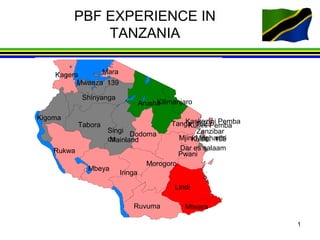3a. tanzania v231110
- 1. PBF EXPERIENCE IN TANZANIA 1 Mbeya Rukwa Tabora Ruvuma Iringa Singi da Dodoma Kigoma Shinyanga Kagera Arusha Mwanza 139 Mara Morogoro Mtwara Lindi Kilimanjaro Tanga 162 Pwani Dar es salaam Kusini 109Mjini Magharibi Kusini Pemba Kaskazini Pemba Mainland Zanzibar
- 2. Background âĒ Area: 926,000 sq km âĒ Population = 40 mil(2002). âĒ Capital: Dodoma âĒ > 120 tribes. âĒ Language: Swahili(English) âĒ Regions: 25 âĒ 133 councils. âĒ Health facilities: 5,618 (2009) 2
- 3. Health indicators âĒ Maternal Mortality- 578/100.000 live births âĒ UMR- 81/1000 live births (TDHS 2009/10) âĒ IMR-51/1000 live births ( TDHS 2009/10) âĒ NMR -26/1000 live births (TDHS 2009/10) âĒ CPR 36% all methods, 27.4% modern methods. (TFR 5.4) âĒ HIV/AIDS prevalence 6% 3
- 4. Health Services System in Tanzania Community Health ServicesCommunity Health ServicesCommunity Health ServicesCommunity Health Services DispensariesDispensariesDispensariesDispensaries Health CentersHealth CentersHealth CentersHealth Centers District HospitalsDistrict HospitalsDistrict HospitalsDistrict Hospitals RegionalRegional HospHosp..RegionalRegional HospHosp.. Specialize/Specialize/ Consultant Hosp.Consultant Hosp. National HospitalsNational Hospitals Specialize/Specialize/ Consultant Hosp.Consultant Hosp. National HospitalsNational Hospitals ReferralReferral systemsystem Community/ HouseholdCommunity/ Household District CouncilDistrict Council Regional SecretaryRegional Secretary Ministry of HealthMinistry of Health 4
- 5. The Current Situation âĒ The Ministry embarked in Health Sector Reform in 90âs and re organize its structure by decentralizing Primary health services- District level. âĒ Allocation formula based on Population 70%, land size 10%, Under five mortality 10 % and Poverty 10%. âĒ District Health Management Teams (DHMT) were established with semi-autonomous authority â Develop Comprehensive District Health Plans where by Pay for Performance is one of the mandatory activity in the Operation Plan 5
- 6. Current situation cont Financial support comes from: 1. Central Government 2. Donors ( Health Basket funds). 3.Council own sources and 4. Other supplementary sources i.e. Cost sharing, Community Health funds(CHF),NHIF. 6
- 7. Current situation contâĶ âĒ The Ministry implement its roles through National StrategyStrategy For Growth and Reduction of PovertyFor Growth and Reduction of Poverty âĒ National Health Policy and five year Health Sector Reform Strategic Plan(2009-2015). âĒ Primary Health Service Development Programme (MMAM) (2007-2017). âĒ Monitoring of Health Sector Performance. 7
- 8. Opportunities to introduce PBF âĒ Existing systems at all levels. âĒ PBF piloting site - Rungwe District. Training: âĒ 12 Faith based organizations (FBOs). âĒ 3 Public owned H/F âĒ CHMT and HMT members (5). âĒ Council Management team (2). Key stakeholders: âĒ Christian Social Services Commission (CSSC), âĒ KCMC,CORDAID. 8
- 9. ChallengesâĶ. âĒ Not in line with the existing National policies. â Employment policy, â Procurement Act. â Local government financial Act /regulations. â Inadequate financial management capacity skills at the low level (Health centers and Dispensaries). âĒ Inadequate data collection system (HMIS) 9
- 10. Way forward âĒ PBF Advocacy should start at the National Level to downward. âĒ Capacity building of health workers on financial management (Public & Private). âĒ Policy review to match with PBF principles. âĒ Improve on HMIS 10
- 11. 11 ASANTENI â ZIKOMO - THANKS











